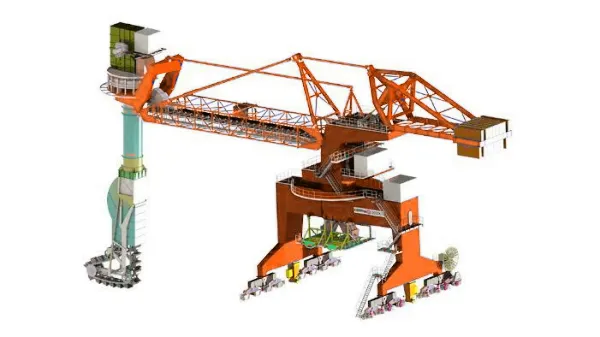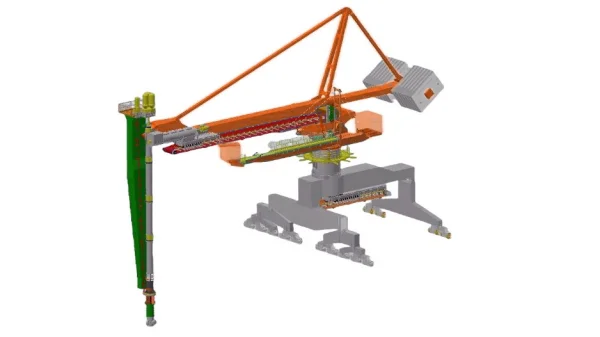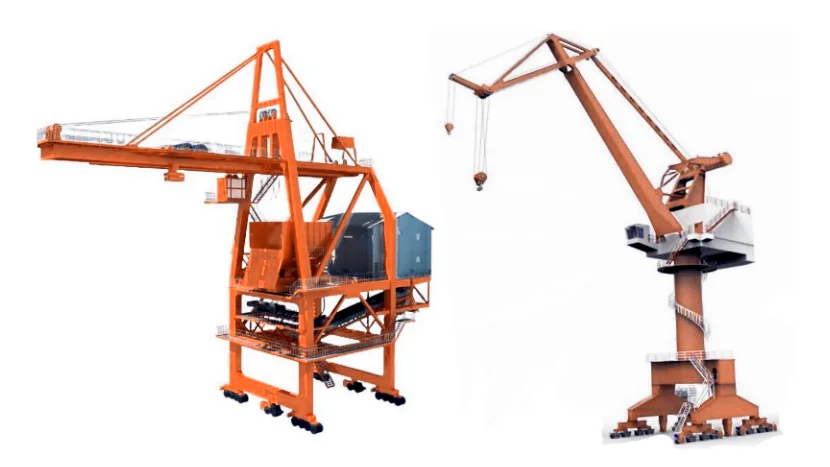Just let we know what you want, and we will get in touch with you as soon as possible!
Mobile Bulk Material Handling Experts
Large-capacity Coal Ship Unloader
A coal ship unloader is a specialized bulk material handling machine used in ports and terminals to efficiently discharge coal from ships (such as bulk carriers) onto shore-based conveyors, stockpiles, or transport systems like trucks and railcars. These systems are essential for high-volume operations in industries like power generation, mining, and steel production, where coal is imported in large quantities. They minimize dust emissions, reduce spillage, and ensure environmental compliance while handling capacities from hundreds to thousands of tons per hour (t/h).

This is a screw ship unloader for coal unloading.
Types of Coal Ship Unloaders
Ship unloaders for coal are broadly divided into continuous (e.g., screw, bucket elevator/chain bucket, bucket wheel) and discontinuous (grab-type) systems. Continuous coal ship unloaders provide steady, high-efficiency discharge, while discontinuous ones are more flexible for varying materials but operate intermittently. Below is a comparison:
| Type | Subtypes/Examples | Capacities (t/h) | Suitability for Coal | Pros | Cons |
| Continuous | Screw-type (e.g., Siwertell) | 200–2,000+ | High (dust-free, efficient for fine coal) | Minimal dust/spillage, high throughput, low energy use | Higher initial cost, less flexible for mixed cargoes |
| Bucket Chain Bucket | Up to 3,000 | High (handles abrasive coal) | Flexible hold emptying, efficient | Heavier structure, potential chain wear | |
| Bucket Wheel | 1,500–2,500 | Medium (good for large volumes) | Compact, lighter design | Limited to certain hold shapes | |
| Discontinuous | Grab-type (e.g., GSU, GVB) | 400–2,500 | High (versatile for coal sizes) | Adaptable to various materials, lower cost | Intermittent operation, higher dust potential |
How Coal Ship Unloader Works?
1. Continuous Ship Unloaders
These systems operate without interruption, using mechanical elements to scoop and convey coal directly from the ship's hold to shore systems. They are mounted on traveling gantries for movement along the quay.
- Screw-Type: A vertical screw conveyor with a counter-rotating inlet feeder submerges into the coal pile. The feeder gathers coal, feeding it into the screw, which lifts it upward. A horizontal arm then transfers it to a gantry conveyor or jetty belt. The vertical arm can pivot (±30 degrees) for reach, and the system includes kick-in/kick-out motions for positioning. Dust is minimized by enclosing the system and using filters.
- Bucket Elevator/Chain Bucket-Type: Buckets attached to a chain dig into the coal, lift it continuously, and discharge into an onboard hopper. From there, it's fed to a conveyor. The system is lighter and uses high-speed belts for elevation.
- Bucket Wheel-Type: A rotating bucket wheel scoops coal and discharges it onto an elevating conveyor, which feeds a hopper and then a dock conveyor. It's compact and suitable for high-speed operations.
2. Discontinuous Ship Unloaders (Grab-Type)
These use intermittent grabbing actions. A crane-like boom with a rope-operated grab lowers into the hold, scoops coal, lifts it, and discharges into a mobile hopper to load trucks or load a belt conveyor. The process then becomes continuous via belt conveyors. Variants include:
- GSU (Cable-Operated Grab Trolley): Winches in the main structure handle grab movements for high speeds.
- GVB (Trolley-Mounted Winches): Motors on the trolley for grab actions, with boom winches in the structure.

This is a chain bucket ship unloader for coal unloading.
Key Features of Coal Ship Unloaders
- High capacity to handle Panamax, Capesize, and even Chinamax coal carriers (50,000–350,000 DWT).
- Enclosed conveyors (belt, screw, or chain) to minimize dust and spillage.
- Dust suppression systems – bag filters, water mist, or aspiration systems at transfer points.
- Mobility – fixed, rail-mounted, or mobile designs depending on port layout.
- Automation – modern unloaders have PLC/SCADA systems for efficient, precise operations.
Applications of Coal Ship Unloaders
1. Coal-fired power plants (import terminals)
At power generation terminals, coal ship unloaders are widely used in coal-fired power plants to efficiently discharge imported coal directly from ships or barges. These unloaders ensure a continuous and reliable fuel supply to silos or stockyards, supporting stable plant operations. For instance, a continuous bucket-chain unloader with a capacity of 2,000 t/h can seamlessly supply coal to a 1,000 MW coastal power station, minimizing vessel turnaround time while maintaining steady energy production.
2. Steel industry raw material ports
In steel and metallurgical plants, coal and coke are critical raw materials for blast furnaces and steel production, making efficient unloading systems essential. Coal ship unloaders in these facilities are designed for high-capacity, continuous operation, with advanced dust-control measures to manage the large volumes of material handled. This ensures smooth integration into the production process while maintaining environmental compliance and minimizing material loss.
3. Large bulk handling terminals
Port coal terminals, whether dedicated to export in countries like Australia and Indonesia or to import in markets such as India and China, rely on coal ship unloaders to handle massive cargo volumes efficiently. These terminals typically employ high-capacity continuous ship unloaders, enabling faster discharge rates that significantly reduce vessel turnaround times. By ensuring quick and reliable coal handling, they support both global export supply chains and domestic energy or industrial demand.
4. Coastal and river-based coal import facilities
At river and inland ports, coal is often unloaded from barges to support regional distribution for industries or smaller power plants. In these settings, portable or mobile unloaders are commonly used due to their flexibility, allowing operators to adapt to varying berth conditions and vessel sizes. This mobility ensures efficient coal handling in locations where permanent high-capacity infrastructure may not be practical or cost-effective.

This is a grab ship unloader for coal unloading.
Coal Ship Unloader Example
A rail-mounted continuous bucket-chain coal unloader with a 3,000 t/h capacity can empty a 150,000 DWT Capesize vessel in ~50 hours, while keeping dust emissions below 50 mg/m³ with proper dust control.
Would you like me to create a comparison table of coal ship unloader types (Grab, Screw CSU, Bucket Chain CSU) showing their capacity, cost, environmental performance, and best application? For specific setups, unloaders often integrate with coal loading conveyors, using cover clamps for dust control during transfer and telescopic chutes at discharge points. If you need diagrams, quotes from manufacturers, or details on a particular type, let me know!

 English
English



